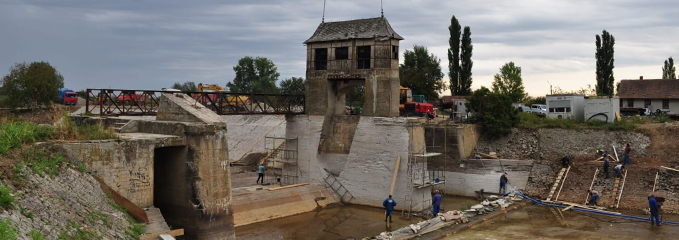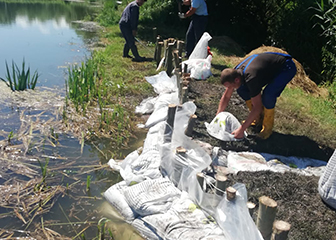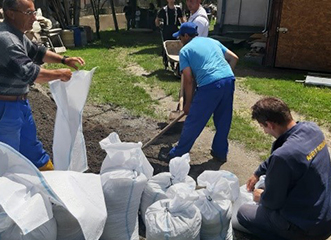We protect ourselves
against floods
Floods are a natural phenomenon, yet, they can cause loss of human life and cause hundreds of million damages annually. Dikes, dams and other protective measures are aimed at keeping us safe, but it is necessary for every Romanian inhabitant to be well informed and prepared. The effective flood management requires cooperation among public institutions, the private sector and the civil society.



Managementul Riscului la Inundatii
Implementarea directivei europene pentru inundatii in Romania
Inundații în zona ta – Bazinele Râurilor
Managementul Riscului la Inundatii
Implementarea directivei europene pentru inundatii in Romania
Inundații în zona ta – Bazinele Râurilor
140 mil/year
Annual cost for economy
2444
Households affected back in 2018
1 billion EUR
Damages avoided annually
Did you know that?
Floods cost on an average 140 million Euro per year for the Romanian economy?
By means of the heritage managed by the “Romanian Waters” National Administration, the National Land Improvement Agency and Hidroelectrica SA, represented by the hydrotechnical works currently existing in Romania, as well as by the operational measures taken during flooding, on an annual basis, potential damages of more than 1 billion Euro are avoided?
The annual flooding on the Danube alone could cause damages of more than 300 mil. Euro if it were not for the dikes and desiccation/drainage systems?
Romania is the fourth among EU countries in terms of flood risks?
A common misunderstanding is that a flood with a return period of 100 years (probability of 1 in 100) is likely to occur once within a 100-year timespan.
Actually, there are about 63.4% chances for one or several floods of more than 1% to occur in any period of 100 years. For instance, the probability for someone to pick all the six numbers in lotto 6/49 is of around 1 in 13. And yet, there are winners indeed.
Two historical floods back in 2005 and 2010 have cumulatively caused 100 casualties and economic losses of more than 2.4 billion EUR?
During the period 2019-2020, the highest temperatures over the last 60 years have been recorded?
The possibility for seriously damaging historical floods increases because of climate change?
MEWF and ANAR have annually invested on an average 60 million EUR in flood risk management projects?
Between 2017 -2021, there have been overall investments of about 331 million Euro in the water management field?
Main causes for increase of the flood risk
Worldwide, the population growth, the effects of urban development and of industrialization have triggered environmental changes which, together with the higher flood intensity and frequency due to climate change, are significantly increasing the flood risk.
Climate change
Climate change takes the form of more frequent and more severe extreme hydro-meteorological phenomena.
They become increasingly stronger with significant adverse effects with heavy rainfalls recorded, in a small area, within a very short period of time.
Watman I – Informational System for Integrated Water Management
The WATMAN project is the largest project for managing and strengthening the institutional and decision-making capacity carried out so far in Romania.
JOINTISZA – Strengthening the Cooperation in Tisza Basin
The project Strengthening the cooperation within the achievement of river basin management plans of and flood risk preventive plans in order to improve the condition of waters in the Tisa River Basin provides the framework for transnational cooperation over the period 2017-2019 in the largest sub-basin of the Danube River Basin.
BRIGAID - Bridging the gap for innovations in disaster resilience
BRIGAID has been a large-scale international project, with the participation of 24 partners, aimed at bringing closer innovators of technologies in the flood risk management, related to draughts and extreme weather conditions, as well as end users.
Danube Water Integrated Management of Cross-Border Waters
The project purpose has been to establish a Romanian and Bulgarian common system for the management and control of the Danube water under extreme conditions, resulting from natural and technological disasters.
Danube Floodplain - Reducing flood risk through floodplain restoration
The main objective of the project has been to improve the transnational water management and flood risk prevention, while maximizing the benefits for biodiversity conservation. The expected change refers to a better awareness, among countries located in the Danube River Basin, of the integrated water management through floodplain restoration, combination of classical and ‚green’ infrastructure, natural retention measures, with the engagement of all stakeholders.
NSFRM – Strengthening the public capacity in FRMP implementation
The project overall objective is the substantiation and support of implementation measures aimed at the adaptation of structures, process improvement and human resources training in order to strengthen the capacity of public authorities and institutions in water management and flood risk management.
Reduction of costal erosion
Projects supporting the flood risk mitigation
The Romanian authorities in charge with the flood risk management are permanently involved in national and international projects resulting in the development of capacities and gaining of new knowledge for preventing and limiting the flood effects.
Examples of flood interventions
The responsible authorities are actively involved in the flood risk management. At operational level, dispatcher’s offices (MEWF, ANAR/RBA) ensure the emergency information flow.
Field teams are monitoring water courses which are placed under different hydrological codes and make interventions, whenever required, by using the existing equipment in order to limit the flooding effects.
Reservoirs take over the excessive water and alleviate the flood waves.



Objectives of the flood risk management plans
- Avoid/Control risks associated to floods.
- Reduce the negative impact of floods on population.
- Reduce the negative impact of floods on infrastructure and economic activity.
- Reduce the negative impact of floods on cultural heritage.
- Reduce the negative impact of floods on environment and achieve/maintain the environmental objectives in accordance with the Water Framework Directive.
- Enhance the level of awareness of and resilience to flood risks, as well as increase the capacity for early warning, alarm, intervention, and response in case of emergency.
- Enhance the level of adaptation to climate change impacts at the level of river basin and coastal area.
- Maximize efficiency in achieving the flood risk objectives, considering the costs and available funding.
- Improve the engagement of all stakeholders.
How we prepare ourselves for the future
Preliminary Flood Risk Assessment
In 2019, the first stage of the second cycle for implementing the Floods Directive was completed, in order to have a new update on the areas of potential significant flood risk.
Flood Hazard and Risk Maps
The Romanian authorities in charge with the flood risk management, alongside with international experts, are currently updating the hazard and risk maps. The new maps and the revised existing ones will be ready by the end of 2022.
Flood Risk Management Plans
By the end of 2022, we will have 11 FRMPs updated at the level of each RBA and one for the Danube River. They will be subject to public consultation for a period of 6 months.
 Weather Warnings
Weather Warnings
